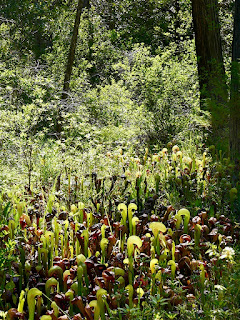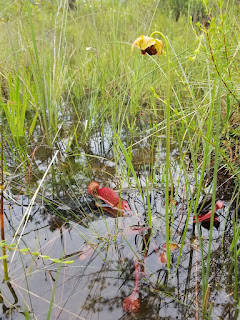Today we conclude our deep dive into the world of carnivorous plants. Mike has been reigniting his passion for these bug eating botanical wonders. Join us as we finish the tour of families of carnivorous plants and the different types of traps they have.
Roridula dentata in the wild. Photograph by Nick Helme via iNaturalist, used under a CC BY-NC 4.0 license.
Roridula dentata flowering in the wild. Photograph by Nick Helme via iNaturalist, used under a CC BY-NC 4.0 license.
Roridula flower. Note the sticky hairs on the leaves. Photograph by Sönke Haas via Flickr, used under a CC BY-ND 2.0 license.
Pamerida bug amongst the sticky tendrils of a Roridula plant. Photograph by tonyrebelo via iNaturalist, used under a CC BY-SA 4.0.
Pamerida bug and numerous prey captured by a Roridula plant. Photograph by felix_riegel via iNaturalist, used under a CC BY-NC 4.0.
Cobra lilies. Note the red fishtail appendages. Photograph by pnwdunning via iNaturalist, used under a CC BY-NC 4.0 license.
Cobra lilies growing in a shaded environment. Photograph by paulexcoff via iNaturalist, used under a CC BY 4.0 license
Darlingtonia growing in the ditch along a gravel road. Photograph by joysavoie via iNaturalist, used under a CC BY-NC 4.0 licnese
Heliamphora chimantensis grown in culture. Photograph by Andreas Eils via Wikimedia Commons, used under a GNU Free Documentation License.
Heliamphora nutans growing on a cliffside. Photograph by thierrycordenos via iNaturalist, used under a CC BY-NC 4.0 license.
Heliamphora nutans growing amonst grasses and other tall competitor plants. Photograph by pfaucher via iNaturalist, used under a CC BY-NC 4.0 license.
Heliamphora pulchella. Note the downward-facing hairs on the inside of the pitchers that help prevent prey from escaping. Photograph by Fernando J. M. Rojas-Runjaic via iNaturalist, used under a CC BY-NC 4.0 license.
Yellow pitcher plants, Sarracenia flava. Photograph by emmatrum vi iNaturalist, used under a CC BY-NC 4.0 license.
Yawning mouth of a yellow pitcher plant. Photograph by wag4ag via iNaturalist, used under a CC BY-NC 4.0 license.
A field of yellow pitcher plants. Such sights were once common in the Southeastern United States but have become more and more rare in the as the bogs and swamps that pitcher plants need were drained and degraded. Photograph by smoran3030 via iNaturalist, used under a CC BY-NC 4.0 license.
Hooded pitcher plants (Sarracenia minor) have lids that overhang the mouth, which is different from the open mouths of many Sarracenia species. Photograph by celiabyrnes via iNaturalist, used under a CC BY-NC 4.0 license.
Note the fenestrae at the back of this Sarracenia minor pitcher that allow light to shine through and fool insects. This morphology is convergent to the fenestrae of cobra lilies and Albany pitcher plants. Photograph by florabundance via iNaturalist, used under a CC BY-NC 4.0 license.
Parrot pitcher plants, Sarracenia psittacina. Note the decumbant (lying along the ground) nature of the traps. Photograph by Andrew Lane Gibson via iNaturalist, used under a CC BY-NC 4.0 license.
Parrot pitchers are the only speices of Sarracenia to regularly become inundated by water and catch aquatic prey. The decumbant traps may be a modification to trap such prey. Photograph by adamhull via iNaturalist, used under CC BY-NC 4.0 license.
Green pitcher plants (Sarracenia oreophila) are critically endangered in the wild. Photography by Farren Dell via iNaturalist, used unde a CC BY 4.0 license.
White pitcher plants (Sarracenia leucophylla) are amongst the largest and most striking species of American pitcher plants. They are commercially harvested for cut flower arrangements and at risk due to poaching. Photograph by stasialr via iNaturalist, used under a CC BY-NC 4.0 license.
Field of white pitcher plants. Photograph by Jared Gorrell via iNaturalist, used under a CC BY-NC 4.0 license.
Purple pitcher plants (Sarracenia purpurea) are amongst the shortest Sarracenia species. The upturned, ruffled lids are distinctive. They are the most widespread Sarracenia species and are found througout the eastern United States and across Canada, nearly to Alaska. Photograph by Scott via iNaturalist, used under a CC BY-NC 4.0 license.Sarracenia × catesbaei, a naturally occuring hybrid between S. flava and S. purpurea. Note the intermediate characteristics this hybrid had between the two parent species. Photograph by Rich Stevenson via iNaturalist, used under a CC BY-NC 4.0 license.
Byblis liniflora, one of the annual rainbow plant species. Photograph by Geoff Shuetrim via iNaturalist, used under a CC BY 4.0 license.
Byblis liniflora in bloom. Photograph by colbourn via iNaturalist, used under a CC BY-NC 4.0 license.
Byblis gigantea, one of the perennial rainbow plant species. Both perennial species are critically engangered. Byblis gigantea is only known from five populations in the wild. Photographs by Jean Hort via iNaturalist, used under a CC BY 4.0 license.
Flower stalk of Byblis liniflora, which has captured a small fly. Photograph by Boaz Ng via Flickr, used under a CC BY-NC-ND 2.0 license.
Philcoxia rhizomatosa growing in white quartitic sand. The underground leaves have been partially exposed by wind. Photograph by william_hoyer via iNaturalist, used under a CC BY-NC 4.0 license.
Philcoxia rhizomatosa. The leaves are usually concealed under the sand. Photograph by william_hoyer via iNaturalist, used under a CC BY-NC 4.0 license.
Closeup of the sticky underground leaves of Philcoxia. Photograph by william_hoyer via iNaturalist, used under a CC BY-NC 4.0 license.A common butterwort (Pinguicula vulgaris) in bloom. This species occurs across the Northern Hemisphere in the United States, Canada, Europe, and Russia. Photograph by bjohnston5 via iNaturalist, used under a CC BY-NC 4.0 license.
Pinguicula moranensis, one of the Mexican butterwort species. Photograph by Raymundo Perez via iNaturalist, used uder a CC BY-NC 4.0 license.
The underground trap leaves of Genlisea bifurcate, with the distal ends being corckscrew shaped, hence the common name "corkscrew plant". Photograph by william_hoyer via iNaturalist, used under a CC BY-NC 4.0 license.
The corkscrew-shaped underground leaves of Genlisea are only a few cells thick and very fragile. The traps leaves of this Genlisea filiformis have broken off where they bifurcate. Note the small size of the adult plant. Photograph by Thiago RBM via iNaturalist, used under a CC BY-NC 4.0 license.
Genlisea margaretae. Photograph by Thilo Krueger via iNaturalist, used under a CC BY-NC 4.0 license.
Genlisea grow in aquatic to semi-aquatic habitats and are thought to require water indundating the traps for the traps to function. Note how these plants are growing nearly submerged. Photograph by william_hoyer via iNaturalist, used under a CC BY-NC 4.0 license.
Common bladderworts found in Pennsylvania. Photograph by Michael Skvarla.
Aquatic bladderworts. Photograph by brieaspasia via iNaturalist, used under a CC BY-NC 4.0.
An epiphytic bladderwort. Photograph by Dr. Alexey Yakovlev via Flickr, used under a CC BY-SA 2.0 license.
Questions? Comments?
Follow the hosts on Twitter @bugmanjon, @JodyBugsmeUNL, and @MSkvarla36
Subscribe to our feed on Feedburner!
This episode is freely available on archive.org and is licensed under Creative Commons: By Attribution 3.0. http://creativecommons.org/licenses/by/3.0/













































